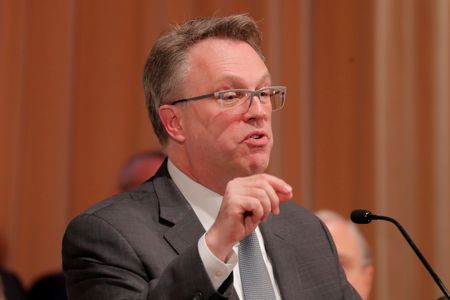
(Reuters) – The head of the New York Federal Reserve on Tuesday brushed aside concerns that the central bank may once again have to call an early end to reductions of its large-scale asset holdings because of a drop in reserves in the banking system.
“I don’t agree with that concern,” New York Fed President John Williams said in an interview with the Wall Street Journal. He had been asked if the decline in bank reserves held at the Fed over the last year augured for a repeat of the market trouble seen in 2019 as its balance sheet reduction program known as quantitative tightening, or QT, shifts into high gear.
As head of the New York Fed, Williams oversees the open market operations that are critical to central bank monetary policy implementation.
In 2019, the central bank was forced to call an abrupt end to its first-ever QT effort when those reserves – which act as one of the key off-setting liabilities on its balance sheet – fell too far. That triggered a liquidity shortage in the $2.2 trillion repo market, which underpins much of the U.S. financial system, and caused a surge in short-term borrowing costs.
The Fed had to inject money to stabilize the market in its first major intervention since the financial crisis.
The Fed started its second bid at QT in June, aiming to right-size a balance sheet that had mushroomed from $4.2 trillion at the onset of the coronavirus pandemic to roughly $9 trillion. The QT effort is set to pick up steam next week when the monthly reduction target doubles to $95 billion.
That anticipated acceleration has sparked concern that the outflow of deposits from banks into money market funds could also reduce bank reserves at such a rapid pace it could hinder lending activities to financial markets and the broader economy. Even before the step up in QT, bank reserve balances at the Fed have dropped to about $3.2 trillion from about $4.2 trillion a year ago.
Williams said the growth in the overnight reverse repo program (ONRRP), which the Fed designed to help counterbalance the drop in bank reserve and is used largely by money market funds, should guard against an unwanted outcome.
“I do see the ONRRP as being a great buffer for us as we reduce the size of our balance sheet,” Williams said. “I actually think it makes it easier. It allows two different parts of our financial system to adjust the liabilities of our balance sheet as we reduce the asset side of our balance sheet. That is running extremely well.”
He added that short-term interest rates were right in the target range and that there’s been “very good” stability in those markets.
“I do expect going forward that we’ll see over time reductions in the balances both of reserves and ONRRP. And that will happen depending on how the adjustment process works but it’s working well and I expect it to continue to,” Williams said.
At roughly $5.7 trillion, the combined liabilities of ONRRP and bank reserves are little changed from year ago and are up since April as the ONRRP balance has rocketed to nearly $2.5 trillion.
The question of sufficient bank reserves and how far QT can proceed has been a center point of discussion, including at last weekend’s annual symposium in Jackson Hole, Wyoming, hosted by the Kansas City Fed. It is not the only question surrounding the outlook for QT, however.
Separate research from the Kansas City Fed and Atlanta Fed earlier this summer concluded that strains in the U.S. Treasury market could complicate the central bank’s plans to reduce its balance sheet by amplifying the effect of those reductions on financial markets and raising interest rates more than anticipated.
Williams, meanwhile, was also asked to address the lack of progress in the runoff of mortgage backed securities from the Fed’s balance sheet: Net MBS holdings are actually slightly higher than they were at the start of the program in early June, whereas Treasury holdings are down by around $70 billion.
Williams noted the pace of reductions depends on market conditions and with interest rates higher, fewer people are refinancing.
“That market takes a little time for things to happen…we are doing exactly what was indicated and any week to week discrepancies really are just more technical factors.”
(Reporting by Lindsay Dunsmuir and Dan Burns; Editing by Andrea Ricci)

